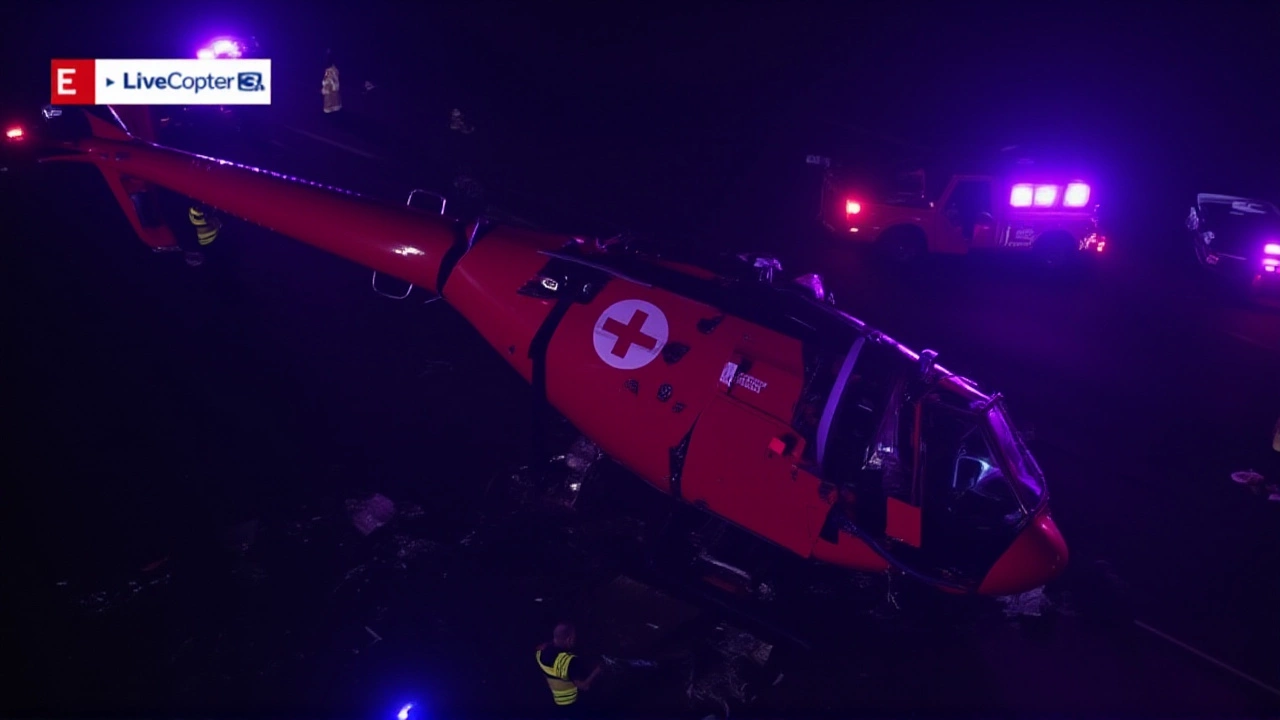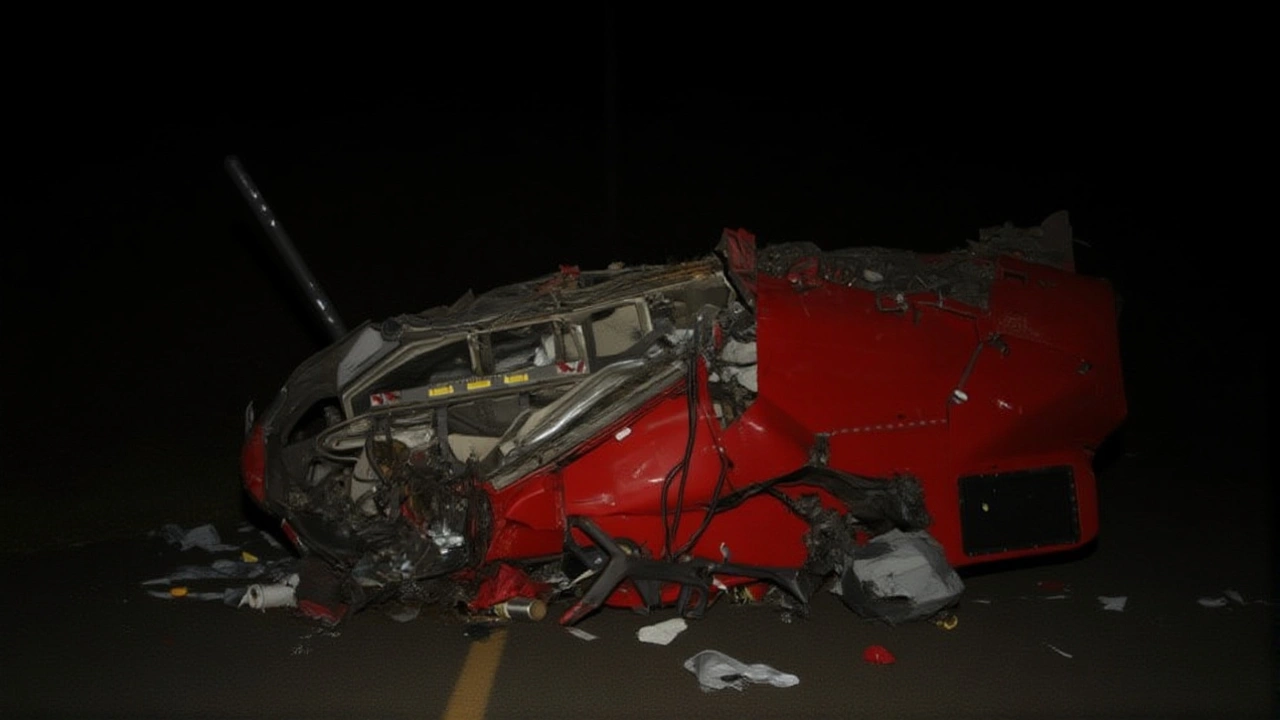Medical helicopter crashes on Sacramento's Highway 50, witnesses aid

Oct, 7 2025
When John Martinez, a construction worker heading to lunch, saw the whir of rotors sputter and a flash of metal on the eastbound lanes of Highway 50 in Sacramento, California, he didn’t hesitate to pull over and rush toward the wreckage. The aircraft, later identified as belonging to Lifeline Air Medical, had slammed into the shoulder at roughly 2:15 p.m. on the medical helicopter crash. Within minutes, other motorists and first‑responders were on scene, pulling away scattered medical equipment and attempting to locate any survivors. The incident left a twisted fuselage, a scattering of red‑cross kits, and a lingering smell of diesel that hovered over the traffic‑jammed freeway for hours.
What happened: timeline of the crash
According to the KCRA 3 crew, the helicopter was on a routine flight transporting a patient from a regional hospital to a specialized trauma center when it experienced an abrupt loss of power. Witnesses describe the aircraft pitching low, striking a traffic barrier, and then skidding across three lanes before coming to rest near the median.
Key moments captured by dash‑cam footage and cell‑phone videos include:
- 14:12 p.m. – Helicopter approaches Highway 50 at an altitude of roughly 250 feet.
- 14:14 p.m. – Engine sputters; pilot attempts an emergency landing.
- 14:15 p.m. – Aircraft clips a concrete barrier, slides, and overturns.
- 14:18 p.m. – First motorists pull over; emergency lights flash.
By the time Sacramento Police officers arrived, the fuselage was still smoking, and the helicopter's air‑medical stretcher lay exposed amid a mess of monitors, IV bags, and a broken radio antenna.
Eyewitness accounts and immediate assistance
"I heard a loud thump, looked up, and saw the rotor blades stop spinning," said Maria Lopez, a commuter who was stuck in traffic. "People started yelling, 'Is anyone hurt?' and a couple of us just ran toward the wreckage."
Martinez and Lopez, along with a handful of other bystanders, formed an impromptu rescue team. They moved the helicopter’s side panel to access the interior, checked for breathing, and flagged down the on‑scene fire engine for additional medical help. Their quick action, while untrained, arguably bought precious minutes before the official rescue crew could secure the site.
Fire Chief Michael Hernandez praised the civilians’ effort, noting that “the public’s instinct to help can make a real difference when seconds count.” The chief added that rescuers later confirmed the patient onboard had already received advanced care before the crash and survived the impact.
Investigation steps and agencies involved
At least fifteen investigators, including members of the Sacramento Police Department (SPD) and the National Transportation Safety Board (NTSB), were documented on the scene throughout the afternoon. They systematically photographed the wreckage, collected black‑box data, and catalogued every piece of medical equipment.
Initial focus was on the left side of the aircraft, where the rotor hub appeared to be detached. By early evening, teams shifted to the right side to examine the fuel system for leaks. The SPD’s forensic unit set up a temporary command post adjacent to the highway, using portable lighting to scan the fuselage from every angle.
Police spokesperson Detective Laura Kim told reporters, "We're following a standard protocol: documenting the scene, securing evidence, and then handing everything to the NTSB for a thorough analysis." The investigation is still in its early stages; no official cause has been released.
Impact on traffic and emergency services
The crash forced a full closure of Highway 50’s eastbound lanes for roughly six hours. Caltrans deployed traffic officers at both ends of the blockage, redirecting vehicles onto Interstate 80 and local arterials. Commuters reported delays ranging from 45 minutes to two hours, prompting the state’s transportation website to post live updates.
Emergency services were stretched thin. With the helicopter occupying a critical stretch of road, an ambulance en route to a separate medical call was forced to turn around, delaying that patient’s care by an estimated 12 minutes. The incident sparked a brief debate among city officials about whether dedicated emergency lanes should be mandated on major freeways.

Possible causes and expert insights
While the NTSB won’t speculate publicly, aviation experts suggest a few plausible scenarios. Mechanical failure, such as a cracked engine turbine, is a common culprit in rotor‑craft accidents. Weather data from the National Weather Service shows that on October 7, 2025, Sacramento experienced light drizzle and wind gusts up to 15 mph—conditions that are generally within a helicopter’s operating envelope but can exacerbate existing mechanical issues.
Dr. Evelyn Shaw, a professor of aerospace engineering at UC Davis, explained, "Helicopters are particularly sensitive to sudden power loss. If a turbine blade fails, the pilot has mere seconds to execute an autorotation landing, which is incredibly challenging over a highway with traffic and obstacles." She added that the presence of the medical kit and the helicopter’s low altitude during the emergency approach likely limited maneuvering options.
What’s next: ongoing investigation and community response
The wreckage remains on Highway 50 as investigators continue to sift through debris. The NTSB is expected to release a preliminary report within 30 days, outlining any immediate findings. In the meantime, Lifeline Air Medical has issued a statement expressing gratitude to the eyewitnesses and promising full cooperation with authorities.
Local hospitals are reviewing their air‑medical protocols, and the Sacramento County health department has opened a hotline for families of crew members seeking information. Community groups have also organized a candle‑light vigil for the crew, scheduled for next Thursday at the Capitol Park.
Frequently Asked Questions
What caused the medical helicopter to crash?
Investigators are still examining the wreckage, but early speculation points to a possible engine failure or sudden loss of power. Weather conditions were mild, so a mechanical issue is considered more likely.
Were there any fatalities?
Current reports indicate that the patient aboard survived the impact, and no crew members were killed. However, official confirmation will come after the NTSB completes its investigation.
How did the crash affect Highway 50 traffic?
The eastbound lanes were closed for about six hours, causing delays of up to two hours for commuters. Caltrans rerouted traffic to I‑80 and nearby surface streets while crews worked to clear the scene.
Who led the on‑scene investigation?
A joint team of the Sacramento Police Department, the National Transportation Safety Board, and Lifeline Air Medical’s safety officers coordinated the investigation, documenting evidence and securing the aircraft’s black‑box data.
What steps are being taken to prevent future crashes?
The NTSB will issue safety recommendations once its analysis is complete. In the meantime, local hospitals are reviewing flight‑crew training and aircraft maintenance records, while city officials are discussing the feasibility of dedicated emergency lanes on major highways.